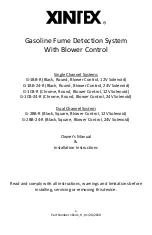
Dual
EL-1484
Location of the Detector
Consider the following before
mounting the detector:
•
Select a location from which the
pattern of the detector is most
likely to be crossed by a burglar,
should there be a break in.
•
Avoid a location that comes in
direct contact with radiators,
heating/cooling ducts or air
conditioners.
•
Do not place the detector in front
of windows subject to direct
sunlight or drafts.
•
Do not place bulky objects in front
of the detector.
•
Microwave energy will pass
through glass and most cons-
truction walls, point the unit away
from outside traffic and rotating
machinery.
Installation Instructions
1.
Open the housing
by removing the front cover. To do so, press the tab located on the bottom of the
detector.
2.
Loosen the PCB screw
, slide the PCB downwards and lift to remove.
Note: Do not touch the face of the
PYRO sensor or MW antenna.
3.
Knock out
the required mounting and wiring holes.
4.
Thread the cable
through the wiring holes (from the outside of the unit) using the appropriate wiring
knockouts.
5.
Seal the wiring hole
with the foam plug provided.
6.
Choose an appropriate mounting height
(recommended 2.2m)
and attach the base to the wall.
7.
Connect the wires
to the terminal block (as shown in figure 2).
TAMPER
RELAY
N.C.
+Vin
GND
ARM
Alarm
Tamper
1
2
3
4
5
6
7
Figure 2: Terminal Blocks
8.
Replace the PCB
and tighten the PCB screw.
9.
Attach the front cover
making sure to click the plastic housing shut.
Operation and Adjustment
Warm-up time:
The detector will need to warm up for the first 90 seconds after applying 9 - 16Vdc.
Note: The unit is to be connected to a UL listed power supply or control unit capable of providing a minimum of
four hours standby power.
Setting the pulse counter:
The pulse counter determines the number of beams that need to be crossed
before an alarm is generated. To set the pulse counter, refer to Table 2 for the appropriate dip-switch setting.
Walk testing the detector:
A walk test determines the coverage pattern of the detector. To perform this test,
walk across the scope of the detector according to the detection pattern selected. Confirm that the LEDs
Terminals 1 & 2:
Alarm Relay Contacts
Terminal 3:
Alarm Memory Control (0V = Disarmed, 12V = Armed)
Terminals 4 (-) & 5 (+):
Voltage Input
Terminal 6 & 7:
Tamper Contacts
PCB
Screw
DIP
Switch
Vertical
Adjustment
Scale
LED
Indicators
MW
Trimmer
Pyro
Sensor
Tamper
Switch
Figure 1: Dual EL-1484 (cover off)
Terminal
Blocks
LED
Disable
Header
MW
Antenna




















